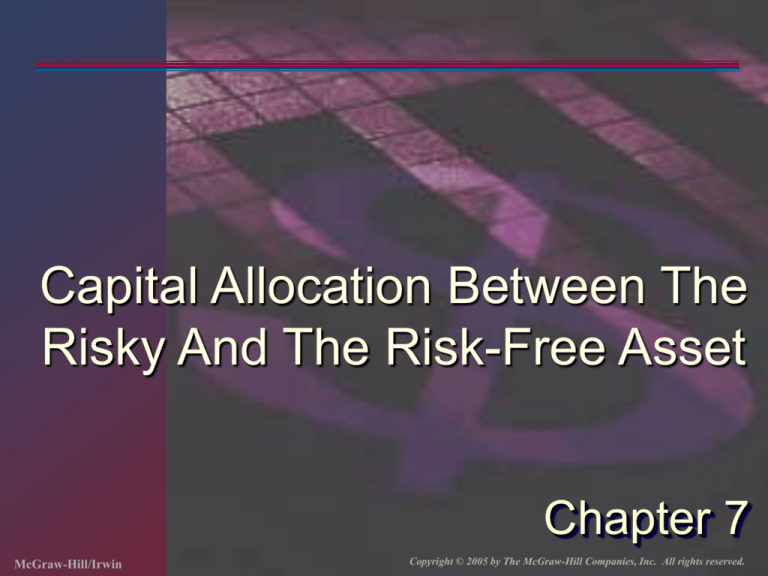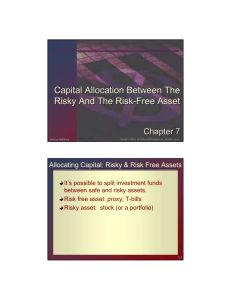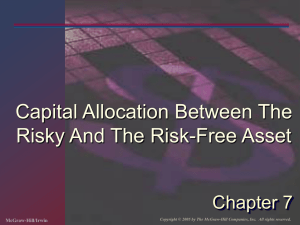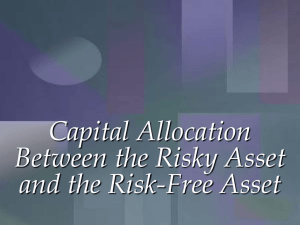
Capital Allocation Between The
Risky And The Risk-Free Asset
Chapter 7
McGraw-Hill/Irwin
Copyright © 2005 by The McGraw-Hill Companies, Inc. All rights reserved.
1. Allocating Capital: Risky & Risk Free Assets
It’s possible to split investment funds between
safe and risky assets.
Risk free asset: proxy; T-bills
Risky asset: stock (or a portfolio).
Capital Allocation Decision: A choice among
broad investment classes rather than among
the specific securities within each asset class.
It is considered as the most important
portfolio construction.
7-2
The Most Basic Asset Allocation Choice
The choice of how much of the portfolio to
place in rf money market instruments vs other
risky assets
Suppose
P; is the investor’s portfolio of risky assets,
F; is the risk-free asset.
P consists of two mutual funds: invested in
stocks, invested in L-T Bonds
7-3
Assume that Initial Portfolio $300,000
$90,000 is invested in the MM Funds
$210,000 in risky securities
$113,400 in equity (E)
$56,600 L-T Bonds (B)
7-4
The weigt of Equity and Bonds in the
Risky Portfolio, P.
113,400
E : W1
0.54
210,000
96,600
B : W2
0.46
210,000
7-5
The weight of the risky portfolio, P, in
the complete portfolio;
Risky assets;
y
210,000
0.70
300,000
Risk-free assets;
1 y
90,000
0.30
300,000
7-6
The weights of each risky assets in the
complete portfolio;
113,400
E
0.378
300,000
96,600
B
0.322
300,000
0.378 0.327 0.70
7-7
Example 7.1
With the same assets suppose you want to
decrease risk by reducing the allocation to
the risky portfolio from y=0.70 to y=0.56.
Risky portfolio: 300,000 x 0.56 = $168,000
You sold 210,000-168,000= $42,000 of your
risky holdings and purchased new shares of
risk-free asset
7-8
Holding in the risk-free asset increase to
90,000+ 42,000= $132,000 or,
300,000 x (1-.56)= $132,000
We leave the proportions of each assets
in the risky portfolio unchanged. We
sold;
.54 x 42,000= $22,680 of E and
.46 x 42,000= $19,320 of B.
7-9
Question 1
What will be the dollar value of your
position in E, and its proportion in
your whole portfolio, if you decide to
hold 50% of your investment budget
in risk-free instrument?
7-10
Solution
Risky asset proportion is decreased
from 70% to 50%.
50% in risky asset.
Proportion of E in the overall portfolio
.50 x 54% = 27%
300,000 x .27 = $81,000
7-11
2. The Risk-free Asset
We commonly view the T-Bills as the “riskfree asset”. Their short-term nature makes
their values insensitive to interest rate
fluctuations.
There are other money market instruments
that may be used by the investors as risk-free
assets such as certificate of deposits and
commercial papers.
7-12
3. Portfolios of One Risky Asset and One Risk-Free
Asset
Issues
Examine risk/return tradeoff.
Demonstrate how different degrees
of risk aversion will affect
allocations between risky and risk
free assets.
7-13
Suppose investor has already decided
on the combination of the risky portfolio.
y: proportion of the investment
allocated to the risky portfolio, P,
1-y: proportion of the investment
allocated to the risk-free asset, F.
7-14
Example Using Chapter 7.3 Numbers
rf = 7%
rf = 0%
E(rp) = 15%
p = 22%
y = % in p
(1-y) = % in rf
7-15
Expected Returns for Combinations
E(rc) = yE(rp) + (1 - y)rf
E(rc) = yE(rp) + (1 - y)rf
= yE(rp)+rf-yrf
E(rc) = rf + y [E(rp)- rf]
7-16
E(rc) = .07+y(.15-.07)
E(rc) = .07 + .08y
For example, y = .75
= .07 + .75(.15-.07)
= .13 or 13%
7-17
Possible Combinations
E(r)
E(rp) = 15%
E(rc) = 13%
P
C
rf = 7%
F
0
c
22%
7-18
Variance For Possible Combined Portfolios
Since
r = 0, then
f
c = y p*
* Rule 4 in Chapter 6
σc=22y
7-19
Combinations Without Leverage
If y = .75, then
c
= .75(.22) = .165 or 16.5%
If y = 1
c
= 1(.22) = .22 or 22%
If y = 0
c = (.22) = .00 or 0%
7-20
The base rate of return for any portfolio is the
risk-free rate. In addition, the portfolio is
expected to earn a risk premium that
depends of the risk premium of the risky
portfolio and the investor’s position in the
risky asset (y).
Investors are assumed to be risk averse and
unwilling to take on a risky position without a
positive risk premium.
7-21
E(rc) = rf + y [E(rp)- rf]
y =σc /σp
c
8
E (rc ) rf [ E (rp ) rf ] 7 c
p
22
Slope;
S
E (rp ) rf
p
8
0.36
22
7-22
CAL (Capital Allocation Line)
E(r)
P
E(rp) = 15%
E(rp) - rf = 8%
) S = 8/22
rf = 7%
F
0
p = 22%
7-23
S; equals to an increase in the expected return of the
complete portfolio for unit of additional standard
deviation. (Incremental return per incremental risk).
For this reason; reward-to-variability ratio.
y=.5
equally divided between P and F
E(rc)= 7+ .5 x (15-7) =11%
Risk premium 4%
δc= .5 x 22= 11%
S= 4 / 11 = .36 the same as that of the portfolio P,
7-24
Capital Allocation Line with Leverage
Suppose the investment budget is
300,000 and we borrow an additional
$150,000, investing into risky assets.
Borrow at the Risk-Free Rate and invest
in stock.
Using 50% Leverage,
7-25
y = 450,000/300,000 = 1.5
rc = (-.5) (.07) + (1.5) (.15) = .19
c = (1.5) (.22) = .33
S = (.19-.07)/.33 = .36
7-26
CAL with Higher Borrowing Rate
In the real world, of course,
nongovernment investors can not
borrow at the risk free rate. Our
borrowing cost will exceed the lending
rate which is 7%. Suppose borrowing
rate is rfB= 9%. Then the new slope is;
S = (.15-.09)/.22 = .27
7-27
CAL with Higher Borrowing Rate
E(r)
P
) S = .27
9%
7%
) S = .36
p = 22%
7-28
The CAL will therefore “kinked” at P.
To the left at P, the investor is lending at
7% with slope 0.36
To the right of P, the investor is
borrowing at 9% with slope 0.27
7-29
In practice, you can borrow and make
investment in risky portfolio. => margin
purchasing
Margin purchase may not exceed 50% of the
purchase value. Therefore if you have
300,000, you can lend up to 300,000 to
purchase additional stock.
You would have $600,000 on the asset side
and 300,000 on the liability side of your
account, y=2.
7-30
Question
Suppose that there is a shift upward in
the expected rate of return on the risky
asset, from 15% to 17%. If all other
parameters remain unchanged, what
will be the slope of the CAL for y that is
smaller than and equal to 1 and that is
greater than 1.
7-31
Solution
S (Lending) = (.17-.07)/.22 = 0.45
S (Borrowing) = (.17-.09)/22 = 0.36
7-32
4. Risk Tolerance and Allocation
We have shown how to develop CAL, the
graph of all feasible risk-return combinations
available from different asset allocation
choices.
Now we must choose one optimal portfolio, C,
from the set of feasible choices.
Individual investors differences in risk
aversion imply that, given an identical
opportunity set ( a rf and slope), different
investors will choose different positions in the
risky asset.
7-33
Greater levels of risk aversion lead to
larger proportions of the risk free rate.
Lower levels of risk aversion lead to
larger proportions of the portfolio of
risky assets.
Willingness to accept high levels of risk
for high levels of returns would result in
leveraged combinations.
7-34
Utility Function
The utility of investors with a given expected return and
std. deviation;
U = E ( r ) - .005 A 2
Where
U = utility
E ( r ) = expected return on the asset or portfolio
A = coefficient of risk aversion (degree of risk aversion)
2 = variance of returns
7-35
U ↑, E(r)↑ U↓ ≠ σ2↑
Risk-neutral investors, A=0
Higher level of risk aversion, larger values for A.
Investor attempts to maximize utility, by choosing the
best allocation to the risky portfolio, y.
Max yU E(rc ) .005 c2 rf y E(rp ) rf .005 Ay2 p2
E(rc) = rf + y[E(rp)- rf]
Optimal position for risk-averse investors in the risky
asset.
E ( rp ) rf
*
y
.01A p2
7-36
Example 7.3
Rf= 7% E(rp)= 15% σp=22%, A=4
15 7
y
.41
2
.01 4 22
*
41% in the risky asset 1-y=59% in risk-free asset
E(rc)= 7+[.41 x (15-7)]=10.28%
σc=.41 x 22 = 9.02%
Risk premium of the complete portfolio;
E(rc)- rf= 10.28- 7= 3.28%
S= 3.28/ 9.02= .36 (reward to variability ratio)
7-37
Indifference Curves
A graphical way of presenting this decision
problem is to use indifference curve analysis.
Indifference curve is a graph in the expected
return- standard deviation plane of all points
that result in a given (same) level of utility.
The curve displays the investor’s required
trade-off between expected return and
standard deviation.
7-38
How to build an Indifference Curve
Consider an investor with A=4 invests all her money into riskfree portfolio rf=5%
Because variance is 0. U=5 =>
We try to hold the utility value at 5.
Expected return when holding a risky portfolio
Say δ=1%
U= E(r)- .005 x A x δ2
5= E(r)- .005 x 4 x 12
E(r)=5.02%
We can repeat this calculation for many levels of δ, finding the
value of E(r) necessary to maintain U=5. Plotting these
combinations gives us the indifference curve.
7-39
Choosing Optimal Complete Portfolio
The more risk-averse investor (with greater A)
has steeper indifference curves than the less
risk averse investor (with lower A).
Higher indifference curves correpond to
higher level of utility.
The investor attempts to find the complete
portfolio on the highest possible indifference
curve.
The optimal complete portfolio is the point at
which the highest possible indifference curve
touches the CAL.
7-40
CAL with Risk Preferences
E(r)
The lender has a larger A when
compared to the borrower
P
Borrower
7%
Lender
p = 22%
7-41
Question
If an investor’s A = 3, how does the optimal
asset mix change?. What are the new E(rc)
and σc?
Suppose that the borrowing rate is 9%, is
greater than the lending rate, 7%. Show
graphically how the optimal portfolio choice of
some investors will be affected by the higher
borrowing rate. Which investors will not be
affected by the borrowing rate.
7-42
Solution
Before y=.41
y
E (rp ) rf
.01 A p
2
15 7
.55
2
.01 3 22
E(rc)= 7+ (15-7) x .55 =11.4 (before
10.28)
δc =.55 x 22=12.1 (before 9.02)
7-43
Solution
Which investors will not be affected by
the borrowing rate y<1=> They are
lending rather than borrowing. So are
not affected by the borrowing rate.
The least risk-averse investors hold
100% in the risky portfolio so y=1.
7-44
Solution
E (rp ) rf
8
8
y 1
2
2
4.84 A
.01 A p .01 A 22
8
A
1.65
4.84
Any investor who is more risk tolerant
(A<1.65) would borrow if the borrowing rate
7%
7-45
Solution
For borrowers
y
E ( r p ) rf
.01 A
B
2
p
Suppose A=1.1
15 7
y
1.50
.01 1.1 4.84
Investor will borrow an amount equal to 50%
of her own investment.
7-46
Solution
Raise the borrowing rate rfB=9%
y
15 9
1.13
.01 1.1 4.84
Only 13% of her investment will be
borrowed.
7-47
Question
You manage a risky portfolio with expected
rate of return of 18% and standard deviation
of 28%. The T-bill rate is 8%.
1. Your client chooses to invest 70% of a
portfolio in your fund and 30% in a T-bill
money market fund. What is the expected
value and standard deviation of the rate of
return on his portfolio?
7-48
Expected return = (0.7 x 18%) + (0.3 x
8%) = 15%
Standard deviation = 0.7x28%= 19.6%
7-49
2. Suppose that your risky portfolio includes
the following investments in the given
proportions:
Stock A: 25%
Stock B: 32%
Stock C: 43%
What are the investments proportions of your
client’s overall portfolio, including the position
in T-bills?
7-50
Investment proportions:
30.0% in T-bills
0.7 25% =17.5% in Stock A
0.7 32% = 22.4% in Stock B
0.7 43% = 30.1% in Stock C
7-51
3. What is the reward-to variability ratio
(S) of your risky portfolio? Your client’s?
7-52
S
18 8
0.3571
28
Your reward-to-variability ratio:
S
18 8
0.3571
28
Client's reward-to-variability ratio:
S
15 8
0.3571
19.6
7-53
4. Draw the CAL of your own portfolio.
What is the slope of the CAL? Show the
position of your client on your fund’s
CAL.
7-54
30
25
CAL (Slope = 0.3571)
20
E(r)
15
%
Client
P
10
5
0
0
10
20
30
40
7-55
7-56
a. E(rC) = rf + y[E(rP) – rf] = 8 + y(18 8)
If the expected return for the portfolio is 16%, then:
16 = 8 + 10 y y 16 8 0.8
10
Therefore, in order to have a portfolio with expected rate of
return equal to 16%, the client must invest 80% of total funds in
the risky portfolio and 20% in T-bills.
b. Client’s investment proportions:
20.0% in T-bills
0.8 25% =20.0% in Stock A
0.8 32% = 25.6% in Stock B
0.8 43% = 34.4% in Stock C
c. sdC = 0.8 x sdP = 0.8 x 28% = 22.4%
7-57
7-58
a. sdC = y x 28%
If your client prefers a standard
deviation of at most 18%, then:
y = 18/28 = 0.6429 = 64.29% invested
in the risky portfolio
b. E(rC) = 8 + 10y = 8 + (10 x 0.6429)
= 8 + 6.429 = 14.429%
7-59
7-60
a.
E(rP ) rf
18 8
10
y
0.3644
2
2
27.44
0.01A P 0.01 3.5 28
*
Therefore, the client’s optimal proportions
are: 36.44% invested in the risky portfolio
and 63.56% invested in T-bills.
b. E(rC) = 8 + 10y* = 8 + (10 x 0.3644) =
11.644%
C = 0.3644 x 28 = 10.203%
7-61
7-62
a. Slope of the CML;
13 8
0.20
25
The diagram follows.
My fund allows an investor to achieve a
higher mean for any given standard
deviation than would a passive strategy, i.e.,
a higher expected return for any given level
of risk.
7-63
CML and CAL
18
16
CAL: Slope = 0.3571
Expected Retrun
14
12
10
CML: Slope = 0.20
8
6
4
2
0
0
10
20
30
Standard Deviation
7-64
7-65
7-66







